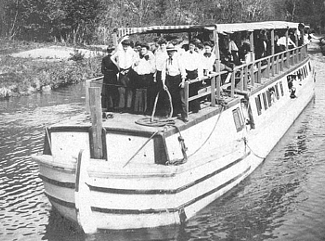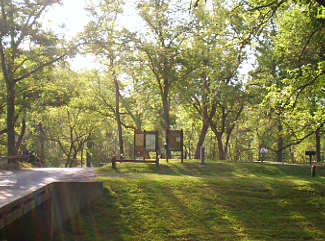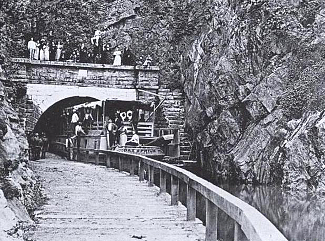
Above: Mule at the Chesapeake and Ohio Canal. Photo courtesy of the National Park Service and the mule. Right: The Potomac River at Fifteenmile Creek, canal behind the scene. Courtesy America's Best History.
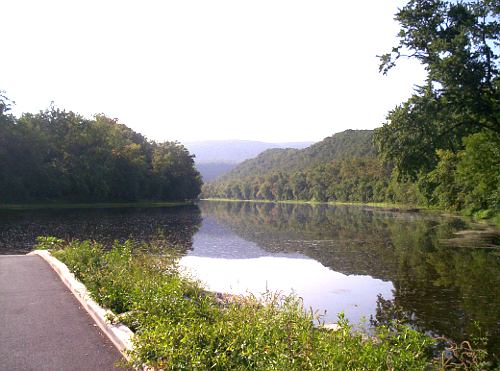
Chesapeake and Ohio Canal
From the Georgetown section of Washington to the mountains of Maryland stretches a canal that at one point moved commerce across the 184.5 miles of water from western settlements to the capital and now moves hikers, bikers, and tourists along the marvelous intact waterways for recreation, camping, and history. It's a varied journey along its path as you wind your away along the route of the Potomac River into the mountains, running directly by historic sites such as Harper's Ferry, plus those of the canal and its seventy-four lift locks and historic lockhouses themselves. And tons of folks do just that each year, in fact, millions, and some of them probably don't even realize that they're quite there, in a history steeped in providing the nation it's bounty as it grew, and in a time when a helmet on a bike rider would have seemed, well, ... a luxury.
Click here to Sponsor the page and how to reserve your ad.
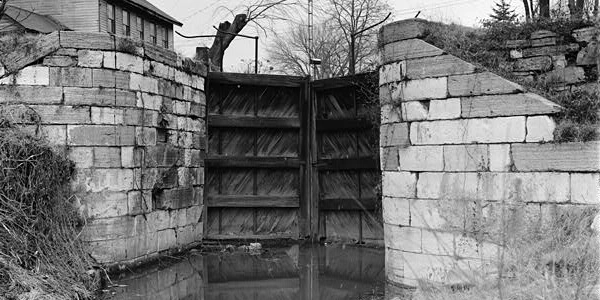
Chesapeake and Ohio Canal Then
A canal system near the capital was a brainstorm of George Washington, who thought that a series of canals connecting the east with the Great Lakes would be great for the expanding nation. His past as an engineer for the British in building the first roads to Pittsburgh may have had something to do with that. In 1785, he founded the Potowmack Company, who built five skirting canals around the falls on the river. Some of these canals would be included, later, in the Chesapeake and Ohio Canal. When John Quincy Adams finally proposed and began the project, it was intended to go all the way to the Ohio River. After twenty-two years of construction, and a cost of $11 milllion, the canal was halted at Cumberland, Maryland. Tolls were collected for the passage of goods, ranging from 1/4 cents to 2 cents per ton per mile. How much was transported? In 1914, for example, 171,062 tons of coal made the trip. Today, you get to witness that length from your car, bike, or feet, and imagine the times when Washington envisioned the waterway to the men and women who patrolled it with coal in their coffers on the way from the mountain mines to the capital. And it will likely take you less time to do that, well, maybe by bike and car, but not by foot, than the fastest canal boat on record, sixty-two hours.
Construction - The canal was begun on July 4, 1828 by President John Quincy Adams and took twenty-two years to build out all the way to Cumberland, Maryland. The intent to go further to the Ohio River did not come to pass. It was built at a width that two canal boats could pass each other simultaneously. There were eleven aquaducts built and seventy-four lift locks to account for the 605' elevation change from one end to the other. The Paw Paw tunnel may have been the most impressive engineering feet on the length of the canal, dug 3,118 feet under the mountains. The tunnel took 12 years to build by itself. It is located between Hancock and Cumberland. The first section of the canal, from Georgetown to Seneca, opened in 1830.
Operation - It took seven days to bring coal from Cumberland down the entire length of the canal to Georgetown, with the boat family moving eighteen hours a day. How much did the family earn for their trip? Try $15 for the week with some reports, due to inflation, of $80 by 1924. Eventually, however, the Baltimore and Ohio Railroad cut into the profit and use of the canal. When a flood damaged the canal in 1924, it ceased operation. The Chesapeake and Ohio Canal became a National Park site in 1971.
Photo above: Lock 44, Williamsport, Maryland along the Chesapeake and Ohio Canal, circa 1933, Jake E. Boucher, Historic American Buildings Survey. Courtesy Library of Congress. Below: Towpath and walking path along grass covered canal at Taylor's Landing. Courtesy America's Best History.
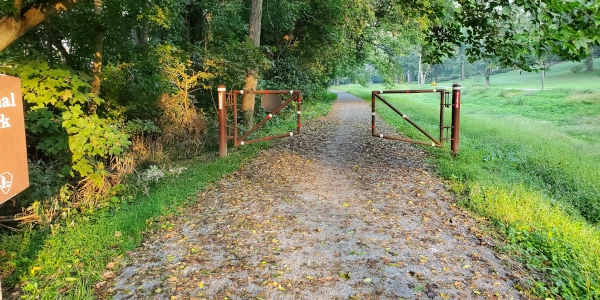
Chesapeake and Ohio Canal Now
The Park - Opened in 1971, the park quickly became a favored place for recreation and history in the mid-Atlantic corridor. The canal wanders from the busy suburbs of the District of Columbia, i.e. Georgetown, to the beautiful scenery of the Maryland mountains. For the adventurous, taking a walk or bike ride along part or all of the miles within the historical park, can be a treat, with camping spots all along the length of the journey. History is interpreted at the various visitor centers, as well as boat rides for the public. It's also a great place to pull out that kayak and ply the waters for yourself.
Minute Walk in History - Chesapeake and Ohio Canal
It's a then and now peek at the Chesapeake and Ohio Canal with period photos and period film, 1917, by Thomas Edison followed by the recreation, camping, and fishing, plus history, that now exists there. With video of the beautiful Potomac River as well as stills of Fifteen Mile Creek, Antietam Creek, and Taylor's Landing, you'll sure want to visit. The music is Ragtime Annie by Charlie Poole and the North Carolina Ramblers followed by Sail Away Lady by Uncle Buck Stevens.
T-Shirts and Souvenirs

Chesapeake and Ohio Canal NHS T-Shirts and Souvenirs from the official gear of americasbesthistory.com.
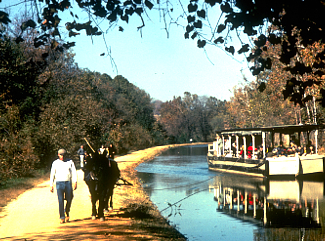
Chesapeake and Ohio Canal
Things You Should Not Miss
1. Take the opportunity to camp along the canal, whether that be by hiking in to one of the more remote campsites situated six to eight miles apart or at one of the five motor in campgrounds. They're well maintained and in some areas, a quiet and remote location to spend the night along the water.
2. Take in a ranger hike. There are several locations along the Chesapeake and Ohio Canal where you can take advantage of the knowledge of the park service staff and learn more about the history, mining, the Great Falls, and the Paw Paw Tunnel. These are predominantly serviced from the Great Falls Visitor Center and the Williamsport Visitor Center. The Paw Paw Tunnel tours are available in the summer only. Check at the visitor center for times and locations of the tours.
3. Stay in a canal lockhouse. We were told you can do that.
Photo above: Boat ride along the Chesapeake and Ohio Canal. Courtesy National Park Service.
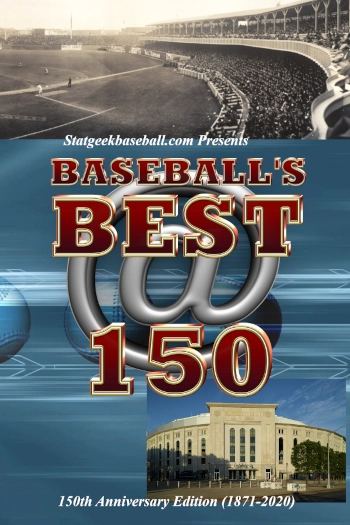
Get Baseball History and Books at Stat Geek Baseball, including Fields of Gold, Baseball's Best Glove Work.
Visitor FAQ

Chesapeake and Ohio Canal Links
Chesapeake and Ohio Canal National Historical Park
Harper's Ferry National Park
Washington, D.C. Visitor Bureau
